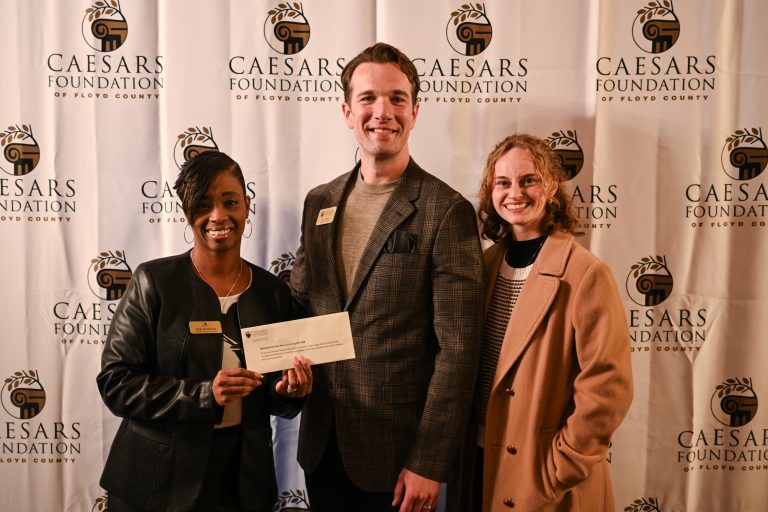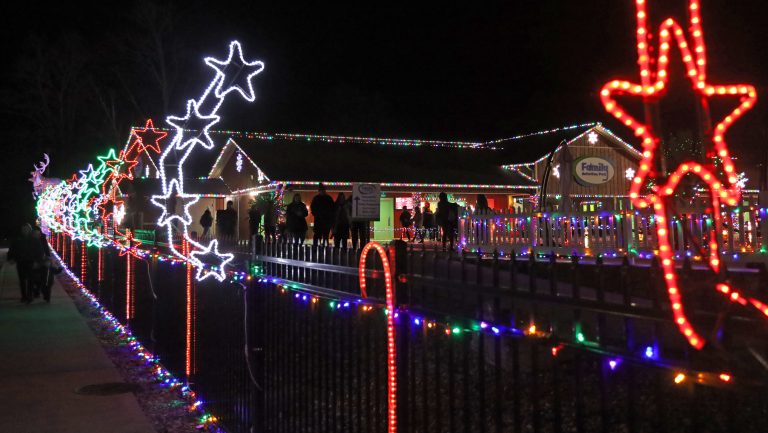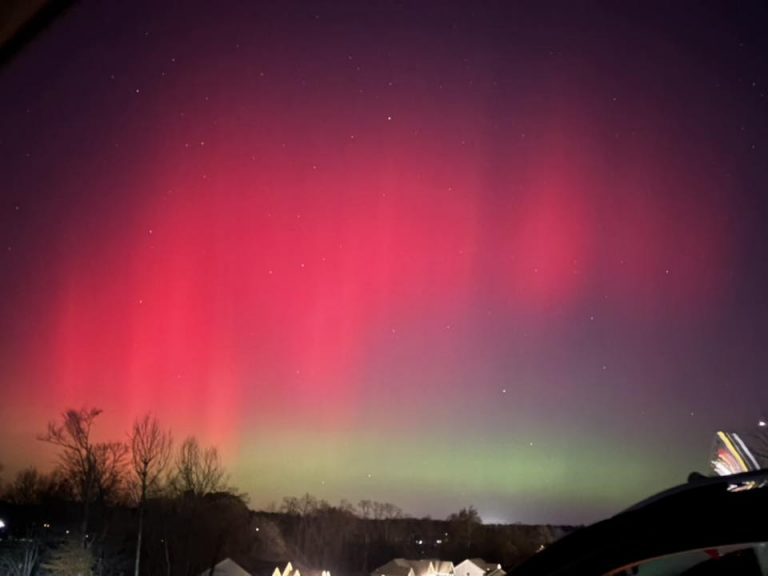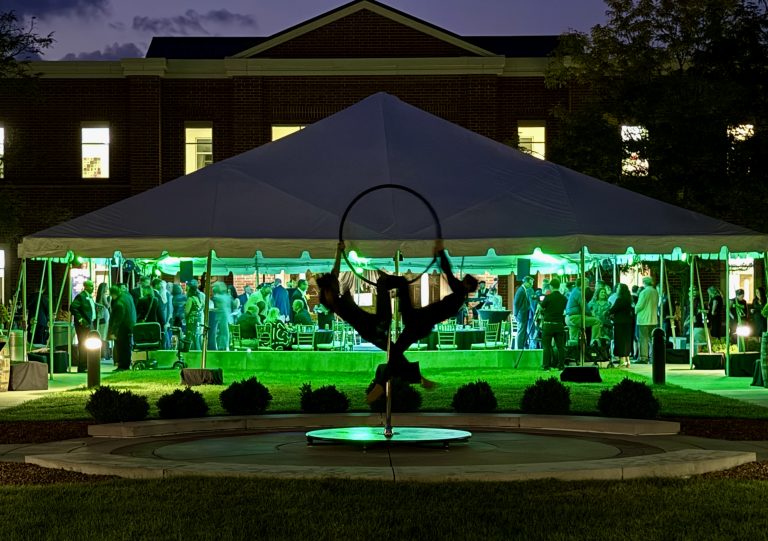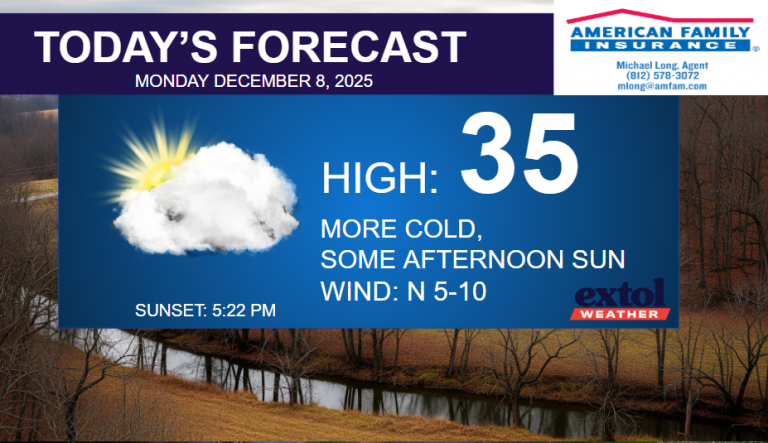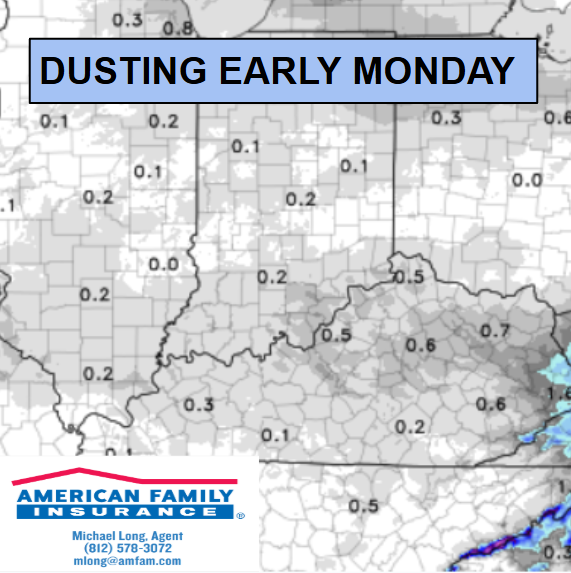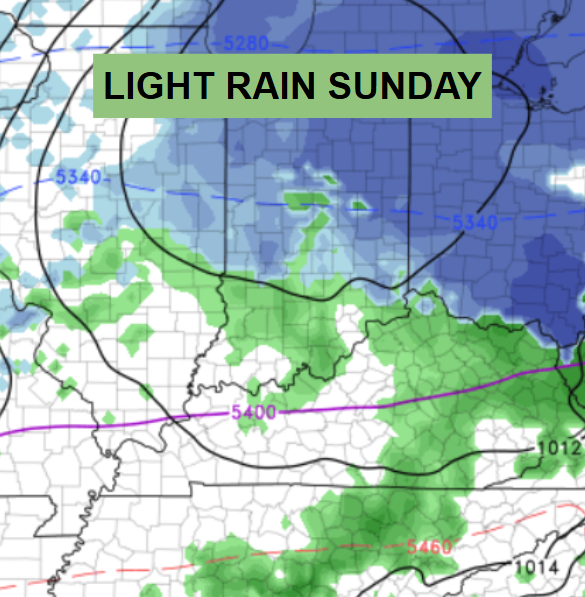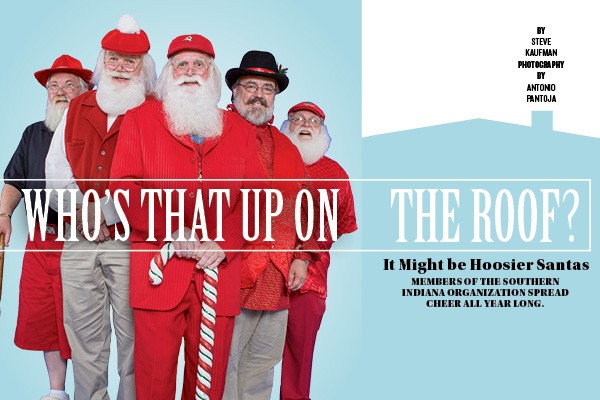
By Steve Kaufman | Photography by Antonio Pantoja
It might be Hoosier Santas
Members of the Southern Indiana Organization Spread Cheer All Year Long
Yes, Virginia, there is a Santa Claus. In fact, there are about 100 of them in Indiana alone. And don’t bother gazing at the midnight sky on Christmas Eve. Or doing the all-night spying on your fireplace. It will be much easier to locate them on Facebook, YouTube, Twitter and email.
Facebook is where Hoosier Santas was started in 2011 by a man in Indianapolis named Larry Shaw, who has embodied the role of Santa Claus for 38 years.
Shaw, now 67, plays Santa at schools and nursing homes, office parties and in people’s homes.
You’ve seen him and his brethren, as well, in the malls and stores, on sidewalks ringing Salvation Army bells, in hospitals, in gas stations and restaurants, on car dealers’ lots and on TV, at fund raisers and charity dinners, in senior communities and homeless shelters, in parades and photographers’ studios, at business openings and ribbon-cuttings, churches and store windows.
Santa Jerry Owens appeared on “The Today Show” and did a commercial for Coca-Cola. Santa Fred Imhausen played a set at an Indianapolis Comedy Club. He also rode on the Polar Bear Express when the Indiana Transportation Museum ran a special Christmas train from Indianapolis to “the North Pole” in Noblesville.
Santa Rich Clamer threw out the first ball at an Evansville Otters baseball game.
There is a nationwide community of these Santas who belong to organizations like the International Brotherhood of Real Bearded Santas. Yet, Shaw saw the benefit of a local organization in which Santas from throughout Indiana could get together during the year, exchange experiences and advice, help find Santa bookings and maintain certain standards of behavior and levels of performance that are important to any professional group.
Being Santa Claus is considered a profession by these men who dress up at Christmastime and say “ho ho ho” on a regular basis. They charge for their appearances, but most take no fees for many of their visits, especially when little children, the needy, the homeless or the elderly are involved. They know what Santa Claus means to little children. They know what Santa meant to them.
“When I was a little kid, I was asked what I wanted to be when I grew up, and I said I wanted to be Santa,” says Clamer of Evansville, now 63. “I thought of Santa as a jolly old soul who loved kids, and that’s who I wanted to be.”
“I explain to new Santas that we have a powerful responsibility,” says Owens of New Albany, who has been portraying Santa in Southern Indiana for 26 years. “If you’re going to look like this man, you’re going to have to think like this man and act like this man, year-round. That means you don’t go to bars, don’t smoke in public, don’t drink, don’t lose your temper. Wherever you go, some child somewhere is looking at you. You have to reflect the individual you’ve chosen to look like, or else trim your beard and do something else.”
Why do they do it?
It can’t be for the money, since being a serious Santa Claus is surprisingly expensive. “My suit alone costs $1,220,” says Owens. “I’m having a suit re-furred right now that’s going to cost me $400, and I have to get it re-furred ever 2 and a half years.”
In fact, most of them disdain those Santas who are motivated by the income opportunities, especially the mall gigs. “Only about 20 percent of our group are mall Santas,” Shaw says.
“Malls are all about the pictures,” Owens explains. “There’s no time to talk to them, to have the satisfaction of seeing a little kid smile.”

Kids and Their Smiles Giving
That – kids and their smiles – is what drives most of these Hoosier Santas. I’ve taught Sunday school for 35-plus years,” says Clamer. “There’s a joy in seeing those little faces light up about wanting to be in Sunday school. It’s the same with Santa Claus.”
“The first time I did it, a kid shouted ‘Santa’ and hugged me around the waist,” says Santa Brian McCutchan of Mt. Vernon. “I began to get the feeling of love, and I wanted to give it back to all these children.”
“I do some auctioneering for Indy Liquidators,” says Imhausen. “A guy asked me if I would play Santa for The Lord’s Pantry at Anna’s House in Indianapolis. I was starting to grow a beard – and it might also have had something to do with my jolly belly. That got me hooked. There are so many things out here to make kids sad. It’s nice to give them one little thing to make them smile.”
Bellies and Beards
The “jolly belly” was the entry point for many of the Santas. Most got into it because, well, they just looked the part. Or they had the right personality. Or fate simply intruded.
“Everyone told me I was starting to look like Santa,” recalls Owens, who worked in the engineering department of the Veterans Association Hospital in Louisville. “At Christmastime, I’d wear a red sweater and red seasonal hat and carry a bag of candy canes with me. When I went into patients’ rooms, they’d say, ‘Santa, what are you doing here?’ I’d hand them a candy cane and say, ‘I’m just checking to see who’s been naughty or Nice’.”
“My daughter’s kindergarten class needed a Santa for a holiday party,” Shaw recalls. “My wife came along as Mrs. Claus, and we fell in love with it. The following year, my wife said, ‘How can we do more of it?’ So we started calling other schools in the area.”
“My wife was working for a local healthcare clinic,” McCutchan recalls, “and a social worker there thought I’d do well around the kids because I have an open personality. I’d done a little theater work in college, so maybe that helped me get into character. We found it rewarding.”
A reward that cannot always be measured in money.
Rewards in Hugs, Smiles and Surprises
“My wife and I did an appearance at a Head Start program for low income children,” says McCutchan, referring to wife Puddy, who always plays his Mrs. Claus. “When we were finished, the young lady in charge gave me some money and I handed it back to her. She hugged me so tight I thought my neck would break.”
“We’re not able to do a whole lot, but there are ways everyone can give back to the community,” says Puddy McCutchan. “This is our way.”
“I did a Santa appearance at a local hospice,” says Owens, “and went up to talk to a woman with Alzheimer’s disease. I introduced myself and her daughter said, ‘She doesn’t talk, she just sits and looks at the floor.’ I got down so she could see my face and said, ‘Merry Christmas, how are you doing?’ She looked up at me and said, ‘Santy, did you bring my kids their presents? They’ve been really good. My little girl makes quilts for the community.’ ”
Owens looked up and the daughter had tears in her eyes. “She’s talking about me. She hasn’t talked like that in years. Thank you!”
Jolly Old Soul
The Santa Claus figure has evolved over the years, as an elf and a spirit, even a woodland sprite, a different-looking figure in the various European cultures, Father Christmas, St. Nicholas and Kris Kringle, usually avuncular but sometimes also spooky and severe.
Shaw says the modern picture of Santa Claus began to emerge with the 1822 Clement Moore poem, “ ’Twas the Night Before Christmas.”
“The beard on his chin was as white as the snow. . . He had a broad face and a little round belly, that shook when he laughed, like a bowl full of jelly.”
But the image we all have of Santa Claus today was solidified by a Coca-Cola advertising campaign in 1931, using a portrait created by illustrator Haddon Sundblom (who also, by the way, created the man on the Quaker Oats box).
Suspicion and Litigation
Sadly, some things have changed for that jolly old elf as our culture has changed. For example, Owens says schools don’t always welcome Santa Claus anymore. “Some schools have issued a blanket refusal,” he says. “Some parents don’t want their children participating, and some principals are afraid parents will be offended.” Apparently, he says, they feel Santa is too closely associated with the Christian religion, which might be offensive to other religions and the non-religious.
Another problem, says Shaw, “is that we live in a suspicious and litigious time. When I started, there were no background checks. Today, we need performer’s insurance, because if a wriggly kid gets dropped, we’ll get sued.
“We started wearing white gloves because when you’re handling little children on your lap. The parents want to make sure they can see where your hands are.”
Another potential lawsuit stems from seeing bruises on a child or having a child tell Santa, “Please make my daddy stop hitting me.”
“You can be legally responsible,” says Shaw, “if they can prove you knew of or were suspicious of abuse and didn’t report it.”
School for Santas
There are training programs and schools around the country that teach Santas the dos and don’ts.
Charles Howard, a department store Santa from Albion, Mich., who debuted Santa in the Macy’s Thanksgiving Day Parade in 1948, established a school, now located in Midland, Mich. There’s also a St. Nicholas Institute in Detroit. “I think there are now 20 schools around the country,” Shaw says. What do they teach, other than how to avoid being sued?
“They teach you how to safely bleach your hair and beard,” says Shaw. “How to maintain yourself and your clothes, what kinds of props you can use.”
They also, he says, “move you from being just a prop, a person in a suit sitting in a chair. They train you to develop back stories to talk about the North Pole, Mrs. Claus, the reindeer, the elves. You’re an entertainer now.”
And they help Santas answer tricky questions.
Santa’s Gift for Giving
Hoosier Santas also looks for ways to bring Santa’s type of service to real-life situations. For instance, in 2012, shortly after Hoosier Santas was formed, they sponsored a toy drive to help the victims of the Henryville tornado. Imhausen says there’s been talk of partnering with the Santa group in Louisiana to benefit victims of the recent flood in the Baton Rouge area.
There’s an aspect of social responsibility that most Santas feel is a part of inhabiting the suit and playing the role. “It isn’t about you and what you can get out of it,” says Santa Jerry Owens. “Ask adults about Santa Claus. They don’t believe in Santa anymore. But they’ve never forgotten what their first experience with him was like.”
He says he frequently encounters people who tell him, “I was having a lousy day until I saw you, Santa. You made me smile.”
Honoring a Beloved Santa
Hoosier Santas is spearheading a drive to have one of their own honored with the Sagamore of the Wabash Award, which is given by the State of Indiana to those who have “contributed to the Hoosier image.”
Among the winners have been David Letterman, Arie Luyendyk, Jeff Gordon and Ryan White. Hoosier Santas is petitioning to add Santa Jim Yellig to that list.
“We, the members of the Santa Claus family and keepers of the Christmas Spirit, come together with one voice to request the great state of Indiana bestow its highest civilian honor to a beloved and legendary Santa, Raymond ‘Jim’ Yellig,” reads the petition.
Yellig, a native of Mariah Hill, Ind., served as Santa at Santa Claus Land (in Santa Claus, Ind.) for nearly 40 years, also appearing in parades across the country and on national TV shows.
“Santa Jim Yellig embodied the definition of distinguished service,” the petition says. “He served his country during a time of war and then continued to serve in a different capacity once he returned home. He brought happiness to millions of children in Indiana, and across the world. His dedicated and selfless portrayal of Santa Claus, and his devotion to spreading the joy of Christmas, all year round, inspired others to follow in his footsteps.
“However,” says the petition, “Santa Jim’s greatest legacy lies in a tradition he ensured would continue for the enjoyment of future generations. The town of Santa Claus, Ind., has been helping Santa answer letters from children around the world for over 100 years. Santa Jim was critical in assisting with these letters. In 1935, he recruited community members and groups, including the American Legion, to help respond to the blizzard of letters arriving in town every year. Thanks to Jim’s commitment to the program, Santa’s Elves continue to respond to letters each Christmas season. In 2015, the Elves answered over 22,000 letters. It is a tradition that delivers smiles and happiness to children and brings the community together.” Hoosier Santas urges people to go online to www.ipetitions.com/petition/ santa-jim-yellig and sign the petition electronically. For more information on Yellig, go to santaclausmuseum.org.
The Things People Say to Santa
WHAT ARE SOME OF HOOSIER SANTAS’ TRICKIER CHALLENGES? AND HOW HAVE THEY HANDLED THEM?
“Will you bring me an iPad for Christmas?”
“Santa should never promise anything,” says Santa Fred Imhausen of Indianapolis. “We don’t know what the family can afford. Or maybe the child asks for a puppy, but the family lives in an apartment house that doesn’t allow dogs. I just say, ‘I’ll bring you a surprise.’ ”
“Santa, Billy’s been a bad boy, tell him you’re going to punish him at Christmastime.”
“I try to say ‘Oh, I’m sure Billy’s a good boy,’ but personally I don’t like when that happens,” Imhausen says. “That’s not our job, we’re not raising the child, though some parents want to use us that way.”
“How do you get down our chimney?” or “We don’t have a chimney.”
“I tell them Santa has a magic key that lets me in the door,” Imhausen says.
“Where are your reindeer?”
“They’re at the airport,” says Imhausen, “resting until Christmas Eve.”
“How can you be here? You’re over at the mall?”
“You’re right about that,” says Santa Rich Clamer of Evansville. “I can’t be everywhere. That’s my brother. We’re all brothers in red.”
“You don’t bring me presents, my parents do.”
“Yes, because you’re one of the fortunate kids, your mom and dad can get you what you want, so I don’t have to go to your house,” says the fast-on-his-feet Clamer. “I say, “There are a lot of kids who don’t have anything, that’s what Santa is all about, making sure they have a great Christmas, too.’ In fact, I encourage them to donate presents to those less fortunate than they are.”
“Can I be Santa some day?”
“I tell them, ‘Sure, maybe next year you’d like to be my head elf,’ ” Rich Clamer says. Adds Linda Clamer, Santa’s Mrs. Claus: “They don’t forget, either. If we forget to bring the elf ’s hat the following year, we’d better be prepared to make one on the spot.”
“NORAD says you’re in Russia right now.”
“One little boy actually produced his iPad to show me that,” Clamer says. “I gave him the big ho-ho-ho and said, ‘That’s my brother. I don’t start until we get to the U.S. The world is so big, one Santa can’t cover it all anymore.’ ”
“Can you make my friend stop being mean to me?”
“I try to comfort the child with the spirit of Christmas,” says Imhausen, “and, separately, I let the parents know what’s going on. Sometimes, though, just giving a child the chance to talk to someone he or she trusts can be important.”
“Can you cure my mommy’s illness?”or “Can you get my mom and dad back together again?”
“Those are the tricky ones,” says Santa Brian McCutchan of Mt. Vernon. “But we’ve been trained never to make promises we know we can’t fulfill,” All I can say is, ‘I’ll say a prayer for you.’ It breaks my heart.”
“You have to be real with these kids,” says Linda Clamer. “If we bless them, they bless us.”
Santa’s Speech
“I have a little stuttering problem,” admits Santa Jerry Owens of New Albany, “which frankly made me a good deal nervous at first about trying to do this. But from the moment I put on that suit, my stuttering disappeared. I’m a different person.”
Owens says he’s even been on television and done commercials, and never had a single problem. Nonetheless, each time he dons the suit in public, he bolsters himself with a little prayer.
“I say, ‘St. Nicholas, please let me perform the way you would have done years ago.’ He’s never failed me.”







